Somewhat unfairly dismissed by Ian McKellen’s James Whale in Gods and Monsters (1998) with the line, “I only made the first two—the rest were made by hacks,” this third Frankenstein picture is admitedly nowhere near the level of Whale’s films, but it is by no means hackwork. It is, in fact, the biggest, most elaborate, and longest of all Universal horror movies of the early sound era—in either the first or second wave of horror. That’s not entirely in its favor—especially that “longest” part. At 98 minutes, it’s about 20 minutes longer than any of its predecessors, but it’s not 20 minutes better. Son of Frankenstein (1939), however, does have a lot of things going for it, though—the sets, the Frank Skinner musical score, a few fine moments for Karloff, an iconic role for Lionel Atwill, an over-the-top lead performance from Basil Rathbone (not everyone considers this a plus), and, best of all, Bela Lugosi’s Ygor. That last is enough to make the film an essential. Everything else is just a bonus in this entry in the Frankenstein saga that has Frankenstein’s son Wolf (Rathbone) following in his father’s misguided footsteps.

The film marked Universal’s return to horror for the first time since Dracula’s Daughter in 1936. Two things changed at that point. There was a kind of moratorium on the genre, mostly because Bride of Frankenstein (1935) and, even more, The Raven (1935) had sent the censors and the moralists into a frenzy. More to the point, though, the Laemmle family had lost the studio to Standard Capital, who put Charles R. Rogers in as head of production. The “ban” on horror suited him just fine, because he didn’t like the genre. He then—Deanna Durbin to one side—proceeded to run “New Universal” (as they at first called themselves) into the ground. So when a desperate theater owner in Los Angeles booked Dracula (1931), Frankenstein (1931), and, somewhat incongruously, Son of Kong (1933) and made a mint, the studio decided that maybe they should rethink the horror ban. Hence, Son of Frankestein.
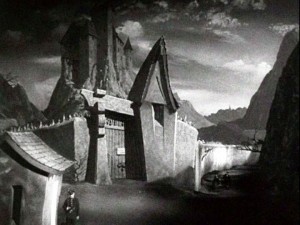
It was always intended to be a Big Picture. In fact, it was planned to be in Technicolor, but either the Monster’s make-up didn’t photograph well, or Selznick had all the Technicolor cameras tied up with Gone with the Wind (both reasons have been put forth), and the idea was dropped. Less clear is why they brough in Rowland V. Lee—and even gave him the 1930s equivalent of “a film by,” “A Rowland V. Lee Production”—is less clear. The new owners apparently neither liked, nor understood Whale, who really was over doing horror movies—especially, Frankenstein ones—and Karloff anyway. Even so, Lee was a curious choice, since apart from two early sound Fu Manchu movies for Paramount, he had no genre credits. He’d just made a romantic comedy for the studio, though, and he must have impressed them. Whatever the case, Lee gave them a handsome film with its own personality.
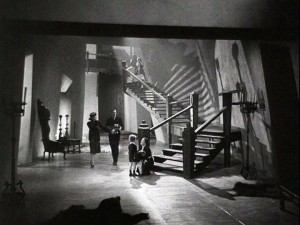
Visually, Son of Frankenstein is remarkable. In large part, this was due to what Lee called the film’s “psychological sets,” which were certainly different—a mix of unadorned planes, expressionist shadows, and twisted “Hansel and Gretel” fairy tale stuff. That last is interesting, because this is the first film to attempt to emphasize the Germanic aspect of the story. Whale’s films made no serious attempt at that. Here, it’s front and center. The late Henry Frankenstein has been entombed as Heinrich von Frankenstein. (Well, no one was ever going to believe that Colin Clive, who played Henry, was a Heinrich or a von anything.) This also features scenes at the very German town council meeting, though—apart from the always welcome Gustav von Seyffertitz—its members tended to be Brits and Americans playing dress-up. The results, nonetheless, were different. Were the sets “psychological?” Probably no more so than any expressionist film, but they did evidence—as Lee’s Fu Manchu films did—a sense of oppressiveness, as if the immensity of the sets was pressing down on the characters.
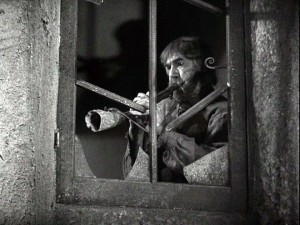
The screenplay—which Lee apparently rewrote or had rewritten as shooting progressed to add scenes for Lugosi*—played fast and loose with the first two movies. Somehow or other the “abandoned watchtower near Goldstadt” that had served as Frankenstein’s lab had scooted on over to the town of Frankenstein and is right next to the castle. It’s also developed a bubbling hot sulfur pit in the process. In 1935, Whale had relented about killing off Henry, reasoning that as long as the Monster was dead, the series was done. He hadn’t reckoned on commerce and the ingenuity of screenwriter Willis Cooper, who decided that the damned thing simply couldn’t be killed, thereby making things a lot easier for subsequent scribes. Nothing had previously suggested that the Monster was anything but mortal. Nothing here actually explains any of this, though Ygor says, “Your father made him live for always.” So there.
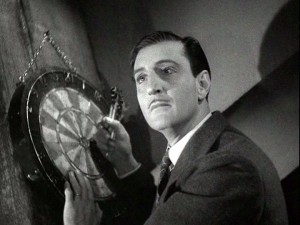
The problem with all this—which would increase as the series went on—was that Whale had been right all along, regardless of Karloff’s objections. There wasn’t much left for a non-talking Monster to do. As a result, the old boy spends a good deal of the film comatose on a slab or an operating table. When he does move around, he has three good moments (though one threatens the sympathy for the Monster), but otherwise comes perilously close to fulfilling Lugosi’s (as played by Martin Landau) claim in Ed Wood (1990)—“It’s all make-up and grunting.” And then there’s the make-up (and that silly wooly vest). Granted, Karloff’s face was much fuller by 1939 and that cadaverous look was gone, but the notion of giving the Monster a kind of beauty mark remains perplexing.
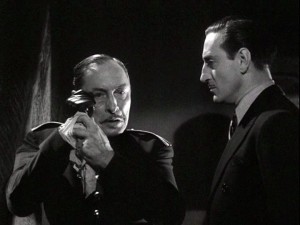
So much does work, though, that it seems a shame to complain too much. Lugosi’s Ygor is one of the actor’s best creations with his sly humor (“Because I stole bodies…er, they said”) and underlying menace. Some of the humor was probably unintentional, especially Ygor’s explanation of his friendship with the Monster—“He’s my friend. He…does things for me.” (Legend has it that every time Lugosi delivered the line, either he, or Rathbone or Karloff would burst out laughing. True or not, the shot that appears in the film is close-up of Lugosi, which could be because of the laughing.) Then there’s Lionel Atwill with his rather noisy fake arm that he uses to hold the darts—by sticking the darts in it—during the game with Rathbone. (The scene was parodied in 1974 by Mel Brooks in Young Frankenstein.) Give a ham a prop like that and you shouldn’t be surprised to find him using it to steal scenes.
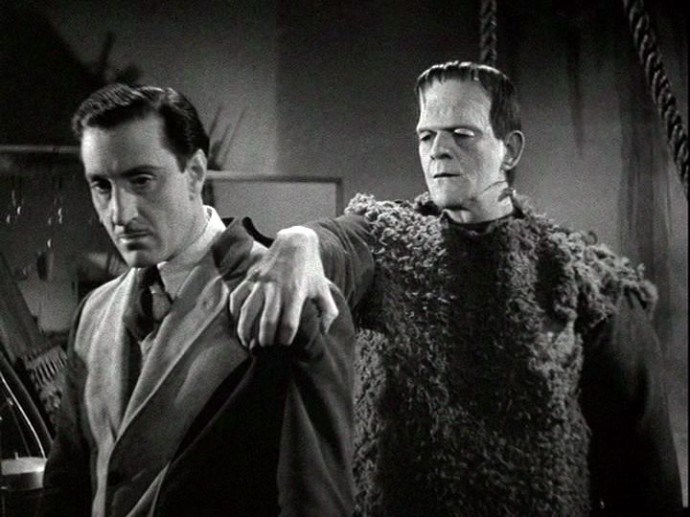
Frank Skinner’s score—which was tossed together in the two weeks prior to the movie’s release—is also a huge plus. It does, however, have to answer for starting the idea of main title themes that allow you to hear the title being “sung” in your mind, since the music clearly indicates “the Son of Frankenstein” over and over, just beating out Max Steiner’s Gone with the Wind main title for that dubious honor.
*According to Lillian Lugosi, Universal planned to just cash in on Lugosi’s name and give him a week or two of work with Ygor. This supposedly so incensed Lee—after all the money the studio had made off him—that he kept padding the role and keeping him there for the entire shoot. The irony is that Lugosi walked off with the film in the bargain.



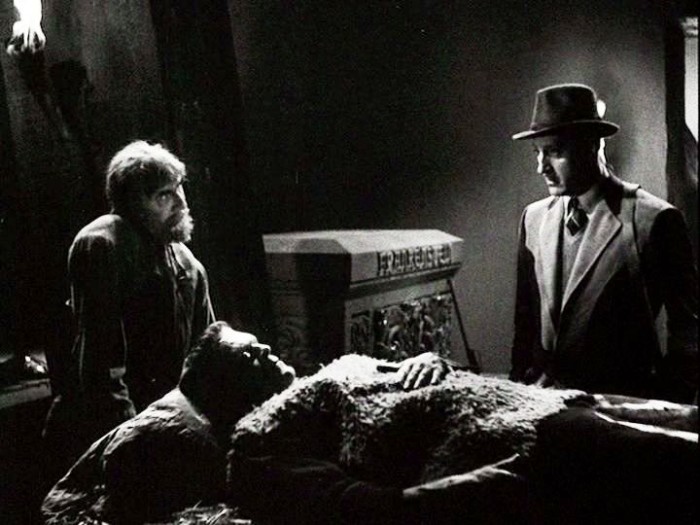
I’ve only seen this on television and as usual am insanely jealous of these big screen showings.
It’s been a few years since I saw it so I think I’ll give the DVD another chance this week with an eye for the things you’ve pointed out. I just recall being kind of disappointed in it. Though considering the quality of horror movies over the past 5 years or so I might think it a masterpiece now.
At least it’s not a cast of physically attractive but otherwise bland, wooden 20-somethings. A lack of any real personality in the sort of generic actors they cast in horror movies now is one of the worst things about them.
I’ve only seen this on television and as usual am insanely jealous of these big screen showings
Will it help if I tell you that the Lounge screen is only about 10 feet wide? It’s still bigger than your TV and seeing these things with 60-80ish other people makes a difference, but it’s not a huge screen.
At least it’s not a cast of physically attractive but otherwise bland, wooden 20-somethings.
Bear in mind that you are getting an obnoxious child actor, along with the old pros. That said, you do get the three Bs — Boris, Bela, Basil — and Atwill. Plus, visitations from Edgar Norton, Lawrence Grant, Gustav von Seyffertitz, Lionel Belmore, Michael Mark, and Clarence Wilson. (The names may not be immediately familiar, but the faces will be.)
A lack of any real personality in the sort of generic actors they cast in horror movies now is one of the worst things about them.
I’m not as hard on modern horror as you are, but there does tend to be something to that.
It’s available on Netflix ‘free’ streaming. Great movie – especially the sets. And Bela — with his little “heh heh” chuckles. (I’ve enjoyed it by ‘resuming’ thru the week to avoid the ‘long-ness’ of it… also easier to savour ;-)
How was the turnout and reaction?
The turnout was okay without being spectacular — 35-40, I guess. The reaction was fine. I think Atwill and his arm actually got more laughs than Lugosi.